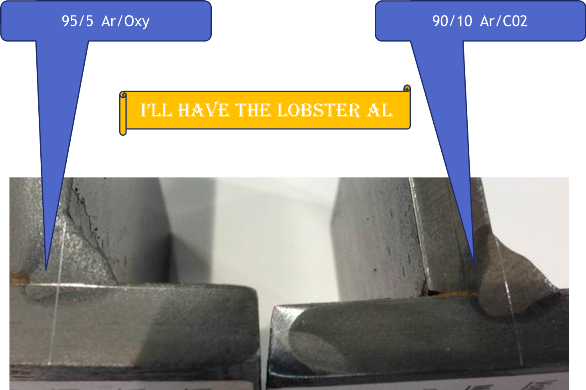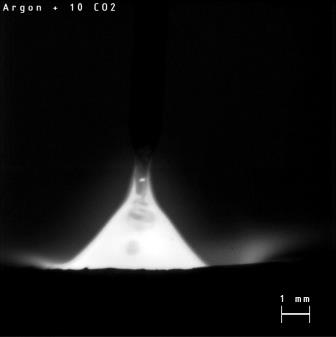
So now you want to pursue the infamous Buried arc again? Okay. let's see what I can come up with...
This book is written by Larry Jeffus and Lawrence Bower (sound Familiar?

) and is titled: "Welding Skills, Processes and Practices for Entry-Level Welders:, Book 2" in the book starting at the bottom of page 9 and continuing through page 10 and I must apologize Larry and Lawrence but I don't have the book personally so I couldn't tell you if the topic of "Buried arc transfer" extends beyond page 10 although if I were to guess, I would say that it does... Here's the link to the book:
http://books.google.com/books?id=EATxJaxrls4C&pg=PA9&lpg=PA9&dq=buried+arc+transfer&source=bl&ots=lgHtAID9Sr&sig=m0A9vu0sDJmH0jz_51iyRx1CwF4&hl=en&sa=X&ei=XTtVVJebLsmuyATtt4LwCw&ved=0CEcQ6AEwBg#v=onepage&q=buried%20arc%20transfer&f=falseHere's the short definition of buried arc transfer from the student resources glossary according to Cengage: "In gas metal arc welding, a method of transfer in which the wire tip is driven below the surface of the weld pool due to the force of the carbon dioxide shielding gas. The shorter arc reduces the size of the drop, and any spatter is trapped in the cavity produced by the arc." Here's the link:
http://www.cengage.com/cgi-wadsworth/course_products_wp.pl?fid=M35&product_isbn_issn=1111039178&chapter_number=10&resource_id=10&altname=Glossary This article is from the Fabricator:
"Globular transfer means the weld metal transfers across the arc in large droplets, usually larger than the diameter of the electrode being used. This mode of transfer generally is used on carbon steel only and uses 100 percent CO2 shielding gas. The method typically is used to weld in the flat and horizontal positions because the droplet size is large and would be more difficult to control if used in the vertical and overhead positions compared to the short-circuit arc transfer.
This mode generates the most spatter; however, when higher currents are used with CO2 shielding and a buried arc, spatter can be greatly reduced. You must use caution with a buried arc because this can result in excessive reinforcement if travel speed isn't controlled."http://www.thefabricator.com/article/consumables/understanding-transfer-modes-for-gmawThis article I believe Lawrence recognizes the author being Jack R. Barckhoff... It was published in the "Welding Design & Fabrication" Magazine in the October issue of 1986...
The title of the article is: "Smart Managers Reduce Arc Time" and the topic of buried arc transfer can be found in the second page of this relatively short article - link:
http://www.barckhoffweldingmanagement.com/articles/smart_managers_reduce_arc_time.pdfThis article focuses on real time application of buried arc transfer and can be found in The Lincoln Electric web site as one of the application stories... This article writes about a pipe mill that was striving to become the most efficient as possible to produce "36" diameter, 0.820" (20.8 mm) thick API 5L Grade X70 produced in 40-foot nominal lengths. The 40 foot long sheet is formed into a tube by Berg's Tri-Roll Bender... Once the plate is formed into the proper tubular shape, the longitudinal weld is completed in three passes, beginning with a continuous tack weld. For the Gulfstream Project, the longitudinal welding procedures were qualified to both ASME Section IX and Berg's internal standards."
"In 1999, Berg had a single, DC 1500 power source. For every diameter change in pipe, the system would require 45 minutes to change out the cage that positioned the plate edges for welding. To eliminate this, Berg turned to the expertise of The Lincoln Electric Company. Because of a long, 21-year relationship with Lincoln, Berg looks to the company for innovative solutions to welding challenges and ways to provide higher productivity in its welding operations. At Lincoln's suggestion, Berg installed a continuous tack welding system utilizing two, DC 1000 power sources and a NA-5 control. This new, CNC-controlled tack welder has hydraulic cylinders, which automatically reposition themselves when the pipe diameter changes. This system has reduced changeover time to approximately five minutes. This new system has also eliminated some of the problems with closing the bevel for welding that Berg Pipe was experiencing with its former system.
These two DC 1000s create a continuous seam tack using an open arc gas-metal arc welding (GMAW) process at high speeds of 260 inches per minute. Commonly referred to as "buried arc", this process is characterized by low voltage, short arc length, and very high travel speeds allowing for a deep penetrating weld at reduced heat inputs.
During tack welding, hydraulic rollers on the system hold the pipe seam together. A laser guidance system from Uhrhan & Schwill is also used to guide the arc in the weld groove and maintain radial alignment of the plate edges. Because this laser guidance was not present on the old tack welding system, it eliminates the time that was needed previously for the operator to stop the weld and adjust these items manually.
While some competitors use intermittent tack welds, Berg Steel Pipe Corporation feels there are benefits to a continuous seam technique to close the formed pipe cylinder for welding. "Intermittent tack welds require the use of a backing flux or a copper backing bar during subsequent submerged arc welding, while ours does not," noted Fred Hafner, PE, Chief Metallurgist/QA Manager for Berg Steel Pipe Corporation. "This means that we achieve higher productivity since the backing provided by the continuous seam provides the attributes for fast travel speeds and deep penetration in ID welding."
Using a buried arc process allows for the elimination of weld spatter typical of globular transfer because the arc is "buried" in the weld puddle. This process also requires only a CO2 shielding gas, eliminating the need for more expensive argon gas. For the tack welding of 0.820" thick pipe, Berg Steel Pipe Corporation uses Lincoln L-50 5/32" diameter wire electrode at 1,500 amps.
Since installing the new system, Berg has been extremely pleased with the results. "Our tacking system is very reliable and helped relieve the problem of the arc outage we were experiencing," said Burton. "We also employ the use of CNC controls which can store data on a particular wall thickness so that we can provide rapid changeovers by simply calling up previously-stored information." " here's the link to the entire application story:
http://www.lincolnelectric.com/en-us/support/application-stories/Pages/berg-steel-pipe.aspxAn interesting article as well to read which is why I edited this post to include it with the rest of the articles and papers:
REVIEW: High speed fusion weld bead defects T. C. Nguyen1, D. C. Weckman*2, D. A. Johnson2 and H. W. Kerr1
* = Corresponding author, email dweckman@uwaterloo.ca,
1 = School of Engineering and Information Technology, Conestoga College, 299 Doon Valley Dr., Kitchener, Ontario N2G 4M4, Canada
2 = Department of Mechanical Engineering, University of Waterloo, Waterloo,Ontario N2L 3G1, Canada
"A comprehensive survey of high speed weld bead defects is presented with strong emphasis on the formation of humping and undercutting in autogenous and non-autogenous fusion welding processes. Blowhole and overlap weld defects are also discussed. Although experimental results from previous studies are informative, they do not always reveal the physical mechanisms responsible for the formation of these high speed weld bead defects. In addition, these experimental results do not reveal the complex relationships between welding process parameters and the onset of high speed weld bead defects. Various phenomenological models of humping and undercutting have been proposed that were based on observations of events in different regions within the weld pool or the final weld bead profile. The ability of these models to predict the onset of humping or undercutting has not been satisfactorily demonstrated. Furthermore, the proposed formation mechanisms of these high speed weld bead defects are still being questioned. Recent welding techniques and processes have, however, been shown to be very effective in suppressing humping and undercutting by slowing the backward flow of molten metal in the weld pool. This backward flow of molten weld metal may be the principal physical phenomenon responsible for the formation of humping and undercutting during high speed fusion welding."
In GMAW with CO2 shielding gas, the buried arc technique has been reported as an effective means of achieving higher welding speeds and filler metal deposition rates.5,10 With this technique, the arc is actually located beneath the original surface of the work piece during welding. This reduces the weld spatter and increases the metal deposition rate. In addition, the overall arc pressure may be reduced since the cathode is located within the weld pool crater.20 This is consistent with the arc pressure and supercritical models wherein a reduction in arc pressure is predicted to decrease the arc gouging directly under the arc, thereby suppressing the formation of humps and undercuts to higher welding speeds and allowing improvements in productivity.4
https://uwaterloo.ca/centre-advanced-materials-joining/sites/ca.centre-advanced-materials-joining/files/uploads/files/2006_review_high_speed_fusion_weld_bead_defects.pdfI'm going to stop here with respect to the buried arc transfer and switch gears to present an investigation that was done back in 2006 @ The Ohio State University Welding
Engineering Laboratory at the Edison Joining Technology Center... The investigation is titled: "INVESTIGATION OF THE EFFECT OF PULSING SHIELDING GAS IN ARC WELDING"
It's an interesting investigation nonetheless... The Abstract starts with this:
"Russian engineers have discovered a new method of delivering shielding gas for arc welding. This new method uses equipment known as the Gas PulserTM to deliver an alternating or “pulsing” supply of two pure shielding gases which are input, creating an alternating supply of shielding gas delivered through a single gas line as opposed to the old method of using premixed shielding gas. The goal of this new “pulsing” method is to create a superior method of atmospheric protection for the molten weld pool."
here's the link to the paper:
https://kb.osu.edu/dspace/bitstream/handle/1811/6450/1/Woods_Steven_Thesis_PDF.pdfWell, that's it for now because it's dinner time and I try very hard not to be late for that!











Respectfully,
Henry





 ) and is titled: "Welding Skills, Processes and Practices for Entry-Level Welders:, Book 2" in the book starting at the bottom of page 9 and continuing through page 10 and I must apologize Larry and Lawrence but I don't have the book personally so I couldn't tell you if the topic of "Buried arc transfer" extends beyond page 10 although if I were to guess, I would say that it does... Here's the link to the book:
) and is titled: "Welding Skills, Processes and Practices for Entry-Level Welders:, Book 2" in the book starting at the bottom of page 9 and continuing through page 10 and I must apologize Larry and Lawrence but I don't have the book personally so I couldn't tell you if the topic of "Buried arc transfer" extends beyond page 10 although if I were to guess, I would say that it does... Here's the link to the book:

















 man o man has this been a revealing thread as well as a long one at that.
man o man has this been a revealing thread as well as a long one at that.








